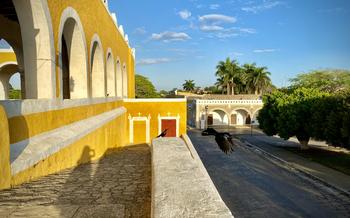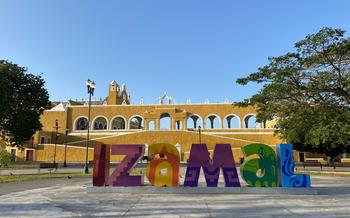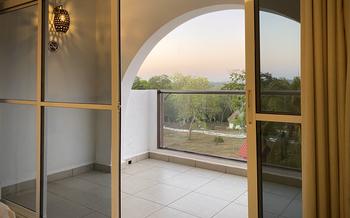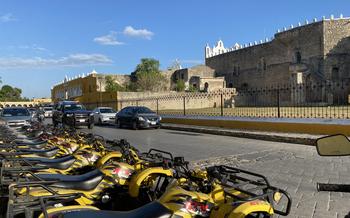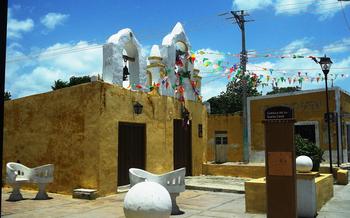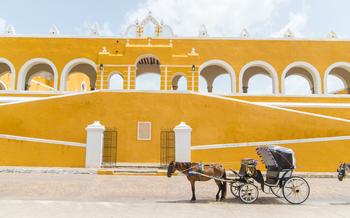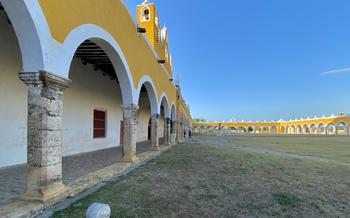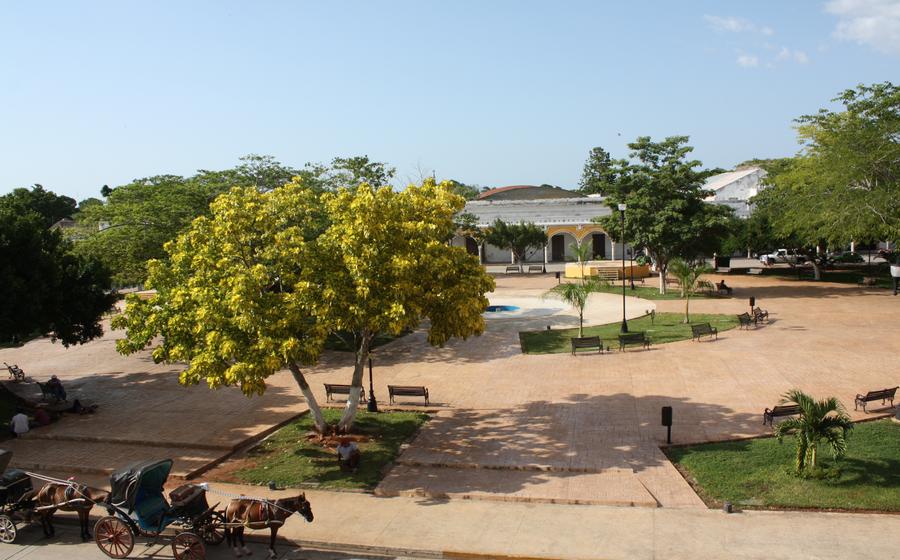
Plaza Izamal
- A City Bathed in Gold:
- Plaza Izamal: The Heart of the City
- Exploring the Franciscan Convent
- Marveling at the Murals of Palacio Municipal
- Climbing the Pyramid of Kinich Kakmó
- Strolling through the Colorful Streets: A Canvas of Colonial Charm
- Shopping for Local Handicrafts
- Indulging in Local Cuisine
- Exploring the Cenotes of Izamal
- Day Trip to the Mayan Ruins of Chichén Itzá
- Discovering the Hacienda San José Cholul
- Attending a Traditional Mayan Ceremony: A Glimpse into Ancient Traditions
- Learning about the Mayan Calendar: A Glimpse into Time
- Insider Tip: Discovering Hidden Gems Off the Beaten Path
A City Bathed in Gold:
Izamal, a captivating city steeped in history and tradition, owes its unique charm to its distinctive yellow hue. This vibrant color, a symbol of wealth and prosperity in Mayan culture, adorns the city's buildings, creating a mesmerizing spectacle that has earned Izamal the title of "Ciudad Amarilla" (Yellow City).
Legend has it that the city's golden glow originated from a miraculous event. In the 16th century, a talking cross is said to have appeared to the Maya, instructing them to paint their city yellow as a symbol of their newfound faith. While the veracity of the legend remains a mystery, the golden hue of Izamal has become an integral part of its identity, captivating visitors with its radiant beauty.
During my visit, I had the privilege of witnessing the mesmerizing effect of Izamal's golden glow at sunset. As the sun dipped below the horizon, the city's yellow facades seemed to ignite, casting a warm and ethereal light upon the streets and buildings. It was a truly magical moment, one that left an enduring impression of Izamal's unique allure.
Plaza Izamal: The Heart of the City
Located in the heart of Izamal, the Plaza Izamal serves as the city's central gathering place, exuding a vibrant atmosphere that pulsates with history and culture. Surrounded by an array of significant buildings, including the majestic Franciscan Convent and the Palacio Municipal, the plaza holds immense historical and cultural importance. Throughout the year, this central square hosts a myriad of cultural events, traditional festivities, and lively markets, making it a hub of activity and a testament to Izamal's rich heritage.
In the evenings, the plaza transforms into a stage for captivating performances of traditional Mayan dances, where the rhythmic beats of drums and the graceful movements of dancers captivate onlookers. The vibrant attire, intricate headdresses, and infectious energy create an enchanting spectacle, offering a glimpse into the city's deep-rooted Mayan traditions. During these performances, the plaza becomes a melting pot of colors, sounds, and emotions, showcasing the vibrant spirit of Izamal.
Exploring the Franciscan Convent
The Franciscan Convent of Izamal stands as a testament to the blending of Spanish and Mayan cultures, a legacy of the colonial era. Built in the 16th century, it is one of the largest convents in the Americas, boasting an impressive atrium, a majestic bell tower, and a church adorned with intricate carvings and frescoes.
Step into the convent's vast atrium, and you'll be greeted by a sense of serenity and awe. The open space is surrounded by arched walkways, creating a tranquil cloister where monks once strolled and contemplated. Look up to admire the bell tower, its silhouette piercing the sky, a symbol of faith and devotion.
Inside the church, the fusion of Spanish and Mayan influences is evident. The vaulted ceilings are adorned with colorful frescoes, depicting biblical scenes and Mayan motifs, a testament to the merging of two cultures. The intricate carvings on the altar and the pulpit showcase the skill and artistry of the Mayan craftsmen who worked alongside Spanish missionaries.
To delve deeper into the history of the convent and its role in the evangelization of the Maya, visit the convent's museum. Here, you'll find artifacts, documents, and interactive displays that shed light on the complex relationship between the Spanish and the Maya, and the cultural exchange that shaped the region.
Insider Tip: Enhance your visit by joining a guided tour of the convent. The knowledgeable guides will provide insights into the history, architecture, and cultural significance of this iconic landmark, ensuring a more profound understanding of its legacy.
Marveling at the Murals of Palacio Municipal
The Palacio Municipal, or City Hall, of Izamal is a magnificent building that houses a series of striking murals depicting the history and culture of the city. These impressive artworks were created by renowned Mexican muralists, including Fernando Castro Pacheco and José Clemente Orozco, and showcase a blend of traditional Mayan motifs and contemporary artistic styles.
The murals adorn the walls of the central courtyard of the Palacio Municipal, inviting visitors to immerse themselves in the rich tapestry of Izamal's past. They depict scenes from the city's founding, the arrival of the Spanish conquistadors, the Maya's resistance to colonization, and the blending of cultures that shaped modern-day Izamal.
One of the most captivating murals portrays the legend of the talking cross, a sacred relic that is said to have guided the Maya people to Izamal. The cross is depicted as a towering figure, surrounded by Maya warriors and priests, and its words of wisdom and guidance are inscribed on the mural in both Spanish and Mayan glyphs.
Another highlight is the mural depicting the traditional Mayan ceremony of Hanal Pixan, or Day of the Dead. This vibrant and colorful mural showcases the Maya's unique customs and beliefs surrounding death and the afterlife, and features skeletal figures engaged in various activities, including cooking, dancing, and playing music.
During my visit to the Palacio Municipal, I had the privilege of meeting a local artist who had worked on the restoration of the murals. He shared fascinating insights into the techniques and symbolism used by the muralists, and explained how the murals were carefully restored to preserve their original beauty and significance.
These awe-inspiring murals are a testament to the artistic talent and cultural heritage of Izamal. They offer a visually stunning and thought-provoking journey through the city's history, inviting visitors to delve deeper into the rich traditions and stories that have shaped this unique and captivating destination.
Climbing the Pyramid of Kinich Kakmó
Standing tall in the heart of Izamal, the Pyramid of Kinich Kakmó beckons visitors with its rich history and breathtaking views. Dedicated to the Mayan sun god Kinich Kakmó, this ancient structure is a testament to the architectural prowess of the Maya. Built using massive blocks of stone, the pyramid rises majestically, offering a unique opportunity to climb to its summit and immerse oneself in the grandeur of the Mayan civilization.
As you ascend the steep steps, take a moment to marvel at the intricate carvings that adorn the pyramid's facade. These carvings depict scenes from Mayan mythology, offering a glimpse into the beliefs and practices of this ancient culture. Once you reach the top, you will be rewarded with panoramic views of Izamal and the surrounding countryside. The golden glow of the city's buildings, set against the backdrop of lush vegetation, creates a mesmerizing sight that is not to be missed.
Insider Tip: To avoid the scorching midday sun, plan your climb to the pyramid either early in the morning or late in the afternoon. The cooler temperatures and softer light will make your ascent more enjoyable, allowing you to fully appreciate the beauty and significance of this iconic landmark.
Strolling through the Colorful Streets: A Canvas of Colonial Charm
Izamal's streets, painted in a vibrant symphony of gold, are a testament to its rich history and cultural heritage. Strolling along these narrow, cobblestone lanes is like stepping back in time, where the charm of the colonial era lingers in every corner. The colorful facades of the buildings, adorned with intricate details and vibrant hues, create a captivating visual feast.
The yellow-painted houses, a signature feature of Izamal, contribute to its unique character. This distinctive color, believed to symbolize purity and divinity, was first used by the Spanish conquistadors to mark the city as a sacred place. Over time, the tradition of painting the houses yellow was embraced by the local Maya, who saw it as a way to honor their ancestors and maintain their cultural identity.
The streets of Izamal are not just a feast for the eyes but also a stage for local artisans to showcase their talents. Street art and murals adorn the walls, adding a contemporary touch to the city's colonial charm. These vibrant artworks depict scenes from Mayan mythology, local traditions, and everyday life, offering a glimpse into the soul of Izamal.
As you wander through the colorful streets, don't miss the opportunity to engage with the friendly locals. They are always eager to share stories about their city, its history, and its traditions. Whether it's a chance encounter with an artisan demonstrating their craft or a conversation with an elderly resident sharing tales of the past, these interactions will enrich your experience and provide a deeper understanding of Izamal's captivating allure.
Shopping for Local Handicrafts
Izamal is a treasure trove of traditional Mayan handicrafts, offering a vibrant array of textiles, pottery, and wood carvings that showcase the region's rich cultural heritage. Strolling through the city's streets, you'll find numerous shops and stalls displaying these exquisite creations.
Supporting local artisans by purchasing their handicrafts is not only a meaningful way to contribute to the preservation of traditional techniques but also a chance to take home a unique piece of Izamal's cultural heritage. The vibrant colors and intricate designs of these handcrafted items make them perfect souvenirs or gifts for loved ones back home.
The best places to find authentic handicrafts in Izamal include the artisan market, located in the heart of the city, and various local shops scattered throughout the streets. At the market, you'll find a wide variety of handicrafts, from colorful hammocks and embroidered blouses to intricately carved wooden figurines and pottery with traditional Mayan motifs.
When shopping for handicrafts in Izamal, don't hesitate to bargain for a good price. It's a common practice and part of the local culture. Moreover, engaging in friendly conversation with the artisans can provide valuable insights into the symbolism and stories behind their creations, making your shopping experience even more enriching.
Indulging in Local Cuisine
Yucatecan cuisine is a unique blend of Mayan and Spanish culinary traditions, boasting a symphony of flavors that will tantalize your taste buds. Must-try dishes include cochinita pibil, a slow-roasted pork dish infused with achiote paste, and papadzules, corn tortillas filled with eggs and topped with a pumpkin seed sauce. For a truly authentic experience, savor relleno negro, a rich black soup made with turkey or chicken and flavored with charred chiles.
Delve into the heart of Izamal's culinary scene by visiting local restaurants and street vendors, where you can indulge in the freshest and most authentic Yucatecan dishes. Be sure to try the regional specialty, Poc Chuc, a grilled pork dish served with pickled onions and habanero salsa.
In a city where food is an art form, I had the privilege of dining at a local restaurant that transported me to the heart of Yucatecan cuisine. The flavors were vibrant, the aromas intoxicating, and each dish was a culinary masterpiece. From the first bite of cochinita pibil to the last sip of horchata, it was an experience that left me craving for more.
Exploring the Cenotes of Izamal
The natural beauty of Izamal extends beyond its colonial architecture and Mayan heritage, encompassing a stunning array of cenotes. These natural wonders are formed by the collapse of underground caves, revealing crystal-clear waters that invite visitors to take a refreshing dip.
Several cenotes are located near Izamal, each offering a unique experience. Cenote Yokdzonot, for instance, boasts a large, open cenote with a wooden platform for easy access. Surrounded by lush vegetation, it's the perfect spot to relax and soak up the tranquil atmosphere.
Cenote Xkeken, on the other hand, is a smaller, more secluded cenote hidden within a cave. Its intimate setting and crystal-clear waters make it ideal for snorkeling and diving, allowing visitors to explore the underwater world of the cenote.
For those seeking adventure, Cenote Suytun offers the opportunity to rappel down into its depths. With its towering walls and refreshing waters, it's a thrilling experience that combines nature and adrenaline.
Insider Tip: To fully appreciate the beauty of the cenotes, consider visiting early in the morning or late in the afternoon when the sun's rays illuminate the water, creating a magical play of light and shadow.
Day Trip to the Mayan Ruins of Chichén Itzá
Just a short drive from Izamal lies one of the most iconic and well-preserved Mayan cities, Chichén Itzá. Step into a world of ancient wonders as you explore the sprawling ruins of this once-thriving metropolis. Marvel at the towering Pyramid of Kukulcan, also known as El Castillo, and climb its steep steps to witness the breathtaking views from the top. Wander through the Great Ball Court, where the ancient Maya played a ritual game with a solid rubber ball, and admire the intricate carvings that adorn the walls. Don't miss the Temple of the Warriors, with its impressive columns and sculptures depicting fierce warriors and mythical creatures. Chichén Itzá is a testament to the ingenuity and artistry of the Maya and offers a glimpse into their advanced civilization.
Insider tip: To avoid the crowds and heat, plan your visit to Chichén Itzá early in the morning or late in the afternoon. Consider hiring a local guide to gain insights into the history and significance of this ancient city, making your exploration even more enriching.
Discovering the Hacienda San José Cholul
Journey back in time as you explore the Hacienda San José Cholul, a testament to the region's rich history and cultural heritage. Once a thriving henequen plantation, this magnificent estate has been transformed into a vibrant cultural center, inviting visitors to delve into the captivating world of Mayan traditions and colonial architecture.
Admire the hacienda's striking architectural features, a harmonious blend of colonial and Mayan styles. Stroll through its lush gardens, where exotic plants and flowers bloom in abundance, creating a picturesque oasis. Immerse yourself in the hacienda's fascinating museum, where exhibits showcase the history of the henequen industry, the daily lives of the Maya, and the cultural significance of this remarkable estate.
Indulge in traditional Mayan cuisine at the hacienda's renowned cooking school. Learn the secrets of preparing authentic dishes, using fresh, local ingredients and traditional techniques passed down through generations. Savor the flavors of cochinita pibil, papadzules, and other Yucatecan delicacies, as you gain a deeper appreciation for the region's culinary heritage.
Discover the hacienda's commitment to sustainability and cultural preservation. Explore its botanical garden, a haven for native plants and a testament to the region's rich biodiversity. Engage with the local community through interactive workshops and cultural events, fostering a sense of connection and understanding.
Whether you're seeking historical insights, culinary adventures, or a glimpse into the vibrant culture of the Yucatan, Hacienda San José Cholul offers an unforgettable experience, leaving you with a lasting appreciation for the region's heritage and traditions.
Attending a Traditional Mayan Ceremony: A Glimpse into Ancient Traditions
Witnessing a traditional Mayan ceremony in Izamal is a profound experience that offers a glimpse into the rich cultural heritage of the region. These ceremonies, deeply rooted in Mayan cosmology and spirituality, are held for various occasions, including weddings, baptisms, and healing rituals.
Each ceremony is unique, showcasing the vibrant colors of traditional Mayan clothing, the rhythmic sounds of traditional music, and the graceful movements of ceremonial dances. The air is filled with the scent of copal incense and the prayers of the participants, creating a sacred and mystical atmosphere.
Attending a Mayan ceremony is not only an opportunity to witness these ancient traditions but also to gain a deeper understanding of the Mayan worldview and their connection to the spiritual realm. It is a chance to learn about their beliefs, rituals, and the profound respect they have for nature and the universe.
Before attending a ceremony, it is important to ask permission from the community elders and to show respect for the sacred nature of the event. Visitors are encouraged to dress modestly and to refrain from taking photos or videos without permission.
Participating in a traditional Mayan ceremony is a truly humbling and enriching experience that allows visitors to connect with the living culture of the Maya and to gain a deeper appreciation for their ancient traditions.
Learning about the Mayan Calendar: A Glimpse into Time
The Mayan calendar stands as a testament to the ingenuity and precision of the ancient Maya civilization. It was more than just a system for measuring time; it was a complex and intricate tool that shaped their daily lives and worldview. The Maya developed two main types of calendars: the Haab', a solar calendar consisting of 365 days, and the Tzolk'in, a sacred calendar of 260 days.
The Haab' calendar was primarily used for agricultural purposes, as it aligned with the solar year and the cyclical changes of the seasons. The 365 days were divided into 18 months of 20 days each, with an additional five-day period known as Wayeb. The Maya believed that Wayeb was a time of transition and uncertainty, when the boundaries between the worlds of the living and the dead were blurred.
The Tzolk'in calendar, on the other hand, was considered a sacred calendar used for religious and divinatory purposes. It consisted of 260 days, divided into 13 months of 20 days each. Each day was assigned a unique name and glyph, and the combination of days and months created a complex system of cycles and patterns. The Maya believed that the Tzolk'in calendar could be used to predict events, determine auspicious days for important activities, and connect with the spiritual world.
My curiosity led me to a local Mayan community, where I had the privilege of learning about the calendar from a knowledgeable elder. He explained the intricate workings of the Haab' and Tzolk'in calendars, demonstrating how they were used to track time, predict astronomical events, and guide their daily lives. Through his teachings, I gained a deeper appreciation for the sophistication and complexity of the Mayan calendar, a remarkable legacy that continues to inspire and fascinate to this day.
Insider Tip: Discovering Hidden Gems Off the Beaten Path
Beyond the main attractions, Izamal offers a wealth of hidden gems waiting to be discovered. For a more immersive experience, venture into the lesser-known corners of the city. Explore the Templo de Santiago, a charming church with intricate carvings and a peaceful ambiance. Wander through the Parque de los Cañones, a tranquil park adorned with cannons and offering a serene escape from the bustling city center.
Extend your exploration into the surrounding countryside, where small villages and cenotes await. Visit the nearby village of Kimbilá to witness traditional Mayan craftspeople weaving intricate textiles and pottery. Discover hidden cenotes tucked away in the lush vegetation, inviting you to take a refreshing dip in their crystal-clear waters.
Engage with the friendly locals, who are always eager to share their stories and recommendations. Ask for their insights on hidden gems and authentic experiences. You may find yourself invited to a traditional Mayan feast, where you can savor delicious home-cooked dishes and learn about local customs. Embracing these off-the-beaten-path adventures will reward you with a deeper understanding of Izamal's rich culture and heritage.

